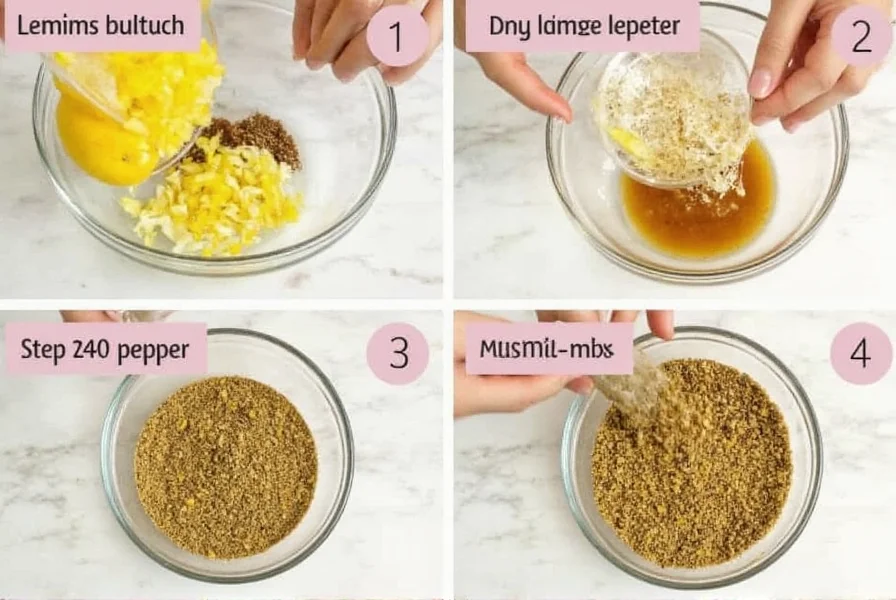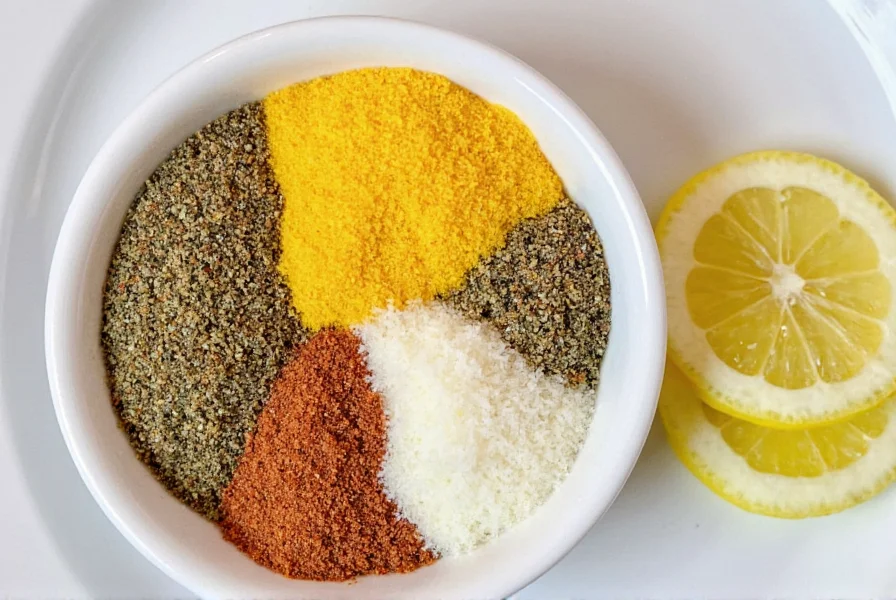Lemon and pepper seasoning has become a staple in modern kitchens for good reason. This simple yet sophisticated blend delivers a bright citrus note balanced with the subtle heat of black pepper, creating a versatile flavor enhancer that works across numerous culinary applications. Unlike single-ingredient seasonings, this combination provides complex flavor dimensions that can transform ordinary dishes into restaurant-quality meals with minimal effort.
Understanding Lemon and Pepper Seasoning Composition
At its core, lemon and pepper seasoning consists of three essential components:
- Dried lemon zest (providing concentrated citrus flavor without moisture)
- Freshly ground black pepper (delivering aromatic heat)
- Sea salt (enhancing and balancing other flavors)
Many commercial blends expand this base formula with complementary ingredients like garlic powder, onion powder, parsley, dill, or even citric acid for intensified tang. The quality of each component significantly impacts the final product—premium blends use real lemon zest rather than artificial flavorings and freshly cracked pepper for superior aroma.

Homemade vs. Store-Bought: A Quality Comparison
Creating your own lemon and pepper seasoning offers distinct advantages over commercial products:
| Factor | Homemade | Store-Bought |
|---|---|---|
| Ingredient Control | Full customization of components | Fixed formula with potential additives |
| Salt Content | Adjustable to dietary needs | Often high in sodium |
| Flavor Freshness | Peak aroma and potency | May degrade during storage |
| Cost per Ounce | Approximately $1.20 | Typically $2.50-$4.00 |
Commercial lemon pepper seasoning often contains anti-caking agents, preservatives, and sometimes sugar or MSG. While convenient, these additions can compromise the pure citrus-pepper experience many home cooks seek. Artisanal brands typically offer better quality than mass-market options but come at a premium price.
Perfect Homemade Lemon Pepper Recipe
Creating restaurant-quality lemon and pepper seasoning requires attention to ingredient ratios and preparation techniques. This professional-grade recipe yields approximately ½ cup:
Ingredients
- 2 tablespoons finely grated lemon zest (from about 3 organic lemons)
- 3 tablespoons freshly cracked black pepper (coarse grind)
- 2 tablespoons flaky sea salt
- 1 teaspoon garlic powder
- 1 teaspoon dried parsley
- ½ teaspoon onion powder (optional)
Preparation Method
- Thoroughly wash and dry lemons, then carefully zest using a microplane grater
- Spread zest on parchment paper and air-dry for 24 hours or dehydrate at 115°F for 2 hours
- Crack whole peppercorns using a mortar and pestle or spice grinder (pulse briefly)
- In a glass bowl, combine all ingredients and mix thoroughly
- Transfer to an airtight container and store in a cool, dark place
This lemon and pepper seasoning recipe creates a balanced blend where neither citrus nor pepper dominates. For low sodium lemon pepper seasoning, reduce or eliminate the salt and add additional herbs for volume. The drying process for lemon zest is crucial—moisture causes clumping and shortens shelf life.

Optimal Culinary Applications
Lemon and pepper seasoning shines in specific applications where its bright, clean profile complements rather than competes with other ingredients. Understanding when to add lemon pepper seasoning during cooking makes a significant difference in flavor development.
Best Uses for Lemon Pepper Seasoning
- Fish and seafood: Sprinkle before baking or grilling (add during last 5 minutes of cooking)
- Chicken dishes: Rub under skin or incorporate into marinades
- Vegetable preparations: Toss with roasted asparagus, broccoli, or zucchini
- Salad dressings: Whisk into vinaigrettes at 1 teaspoon per serving
- Grain dishes: Stir into couscous, quinoa, or rice pilaf
For lemon pepper seasoning chicken recipes, apply generously to skin-on chicken pieces 30 minutes before cooking to allow flavors to penetrate. When using with delicate fish like tilapia or cod, apply more sparingly—about half the amount used for heartier salmon or tuna.
Nutritional Profile and Dietary Considerations
A standard ¼ teaspoon serving of traditional lemon pepper seasoning contains approximately:
- Calories: 2
- Sodium: 190mg (8% of daily value)
- Vitamin C: 1.5mg (2% of daily value)
- Zero fat and carbohydrates
The primary health consideration with commercial blends is sodium content, which can reach 400mg per serving in some brands. Those following low sodium diets with lemon pepper seasoning should either make their own version with reduced salt or seek specialty blends specifically formulated for reduced sodium intake. The lemon component provides a small amount of vitamin C and beneficial citrus compounds, though not in therapeutic quantities.
Common Mistakes to Avoid
Even experienced cooks make these frequent errors with lemon pepper seasoning:
- Adding too early in cooking: High heat diminishes citrus notes—add during final cooking stages
- Over-application: Start with ½ teaspoon per serving and adjust upward
- Using with conflicting flavors: Avoid pairing with heavy spices like cumin or smoked paprika
- Storing improperly: Keep in airtight container away from light and moisture
- Using old seasoning: Discard after 6 months for optimal flavor (12 months maximum)
Understanding how much lemon pepper seasoning to use prevents overpowering dishes. As a general rule, use ¼ teaspoon per 4 ounces of protein or 1 cup of vegetables. For salad dressings, incorporate ½ teaspoon per tablespoon of oil.
Creative Variations and Substitutions
Adapt lemon pepper seasoning for different culinary traditions and dietary needs:
- Mediterranean version: Add dried oregano and a pinch of sumac
- Asian-inspired blend: Incorporate lemon grass powder and white pepper
- Smoked variation: Replace ¼ of black pepper with smoked sea salt
- Lemon-dill alternative: Substitute parsley with dried dill for seafood
- Pepper-forward version: Increase black pepper ratio by 50% for bold flavor
When substituting for lemon pepper seasoning, combine equal parts lemon zest powder and freshly cracked pepper. For lemon pepper seasoning substitute without salt, use citrus-infused sea salt separately from the pepper component to maintain control over sodium levels.
Frequently Asked Questions
What's the difference between lemon pepper and lemon and pepper seasoning?
Traditional lemon pepper seasoning typically includes salt as a primary ingredient (often comprising 30-40% of the blend), while lemon and pepper seasoning may refer to a salt-free version. Commercial "lemon pepper" products almost always contain salt, whereas "lemon and pepper seasoning" suggests a more customizable blend where salt content can vary.
Can I use lemon pepper seasoning in place of black pepper?
Yes, but with adjustments. Lemon pepper contains salt and citrus elements, so when substituting for plain black pepper, use approximately half the amount and reduce additional salt in your recipe. For dishes where citrus complements the flavors (like fish or chicken), this substitution works well, but avoid in recipes requiring pure pepper flavor without citrus notes.
Why does my homemade lemon pepper seasoning clump?
Clumping occurs when moisture remains in the lemon zest. Properly dried zest should be brittle and snap when bent. Ensure you've thoroughly air-dried or dehydrated the zest before mixing with other ingredients. Adding ½ teaspoon of uncooked white rice to your storage container can absorb excess moisture and prevent clumping in finished seasoning.
What dishes should I avoid using lemon pepper seasoning with?
Avoid using lemon pepper seasoning with dishes featuring strong competing flavors like heavy tomato sauces, barbecue rubs, or Indian curries. It also doesn't pair well with sweet preparations or desserts. The citrus notes can clash with dairy-heavy dishes like alfredo sauce, and the pepper can overwhelm delicate flavors in dishes like steamed white fish or simple green salads.
How can I make my lemon pepper seasoning more intense?
For more intense lemon flavor, increase the lemon zest ratio by 25-50% and consider adding ¼ teaspoon of citric acid. To intensify pepper notes, use a combination of black, white, and pink peppercorns. Toasting whole peppercorns before grinding enhances their aromatic compounds. For restaurant-style intensity, add a small amount of lemon oil (¼ teaspoon per batch) which provides concentrated citrus flavor without moisture.











 浙公网安备
33010002000092号
浙公网安备
33010002000092号 浙B2-20120091-4
浙B2-20120091-4